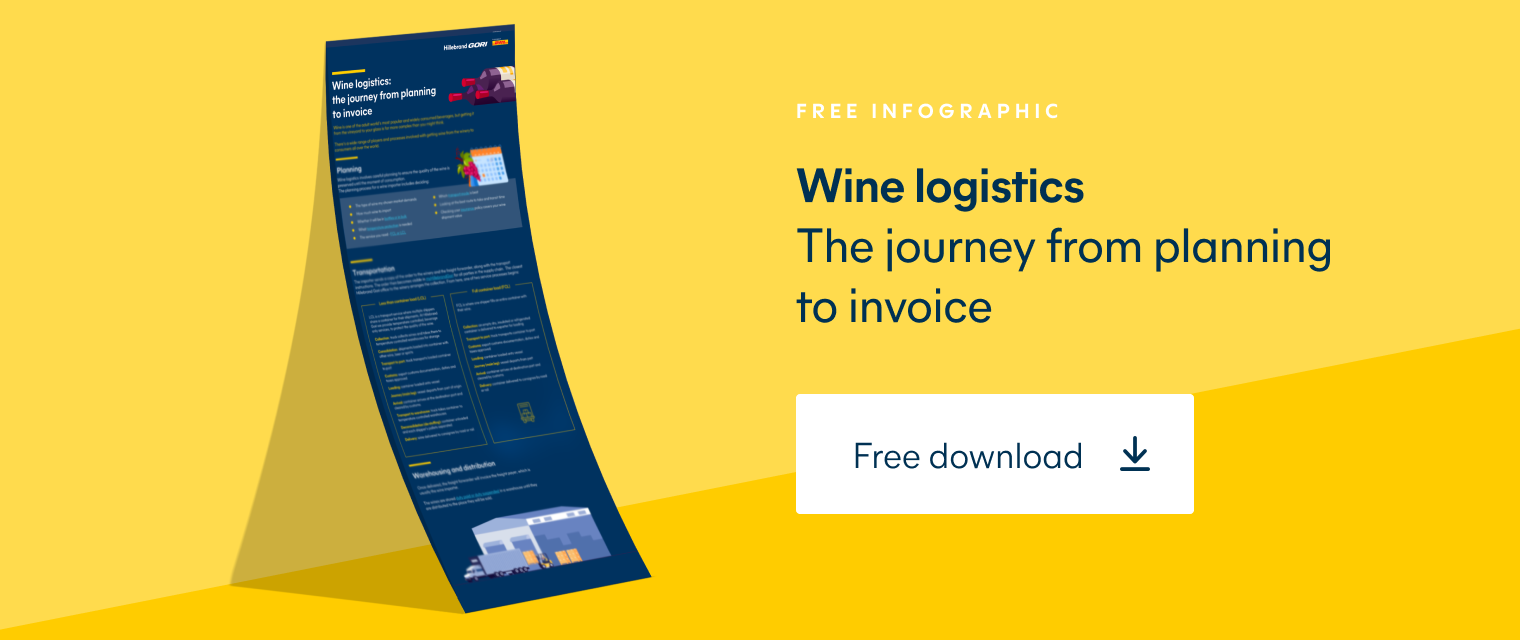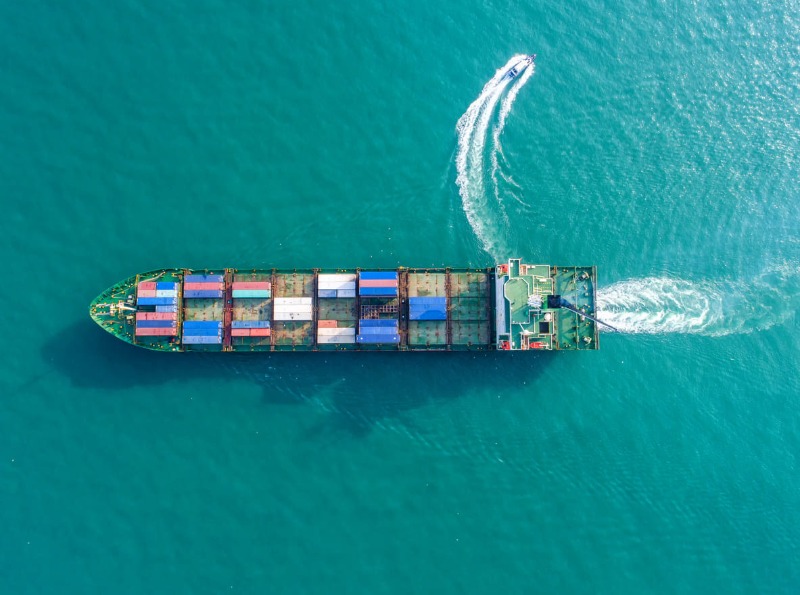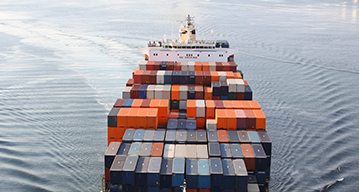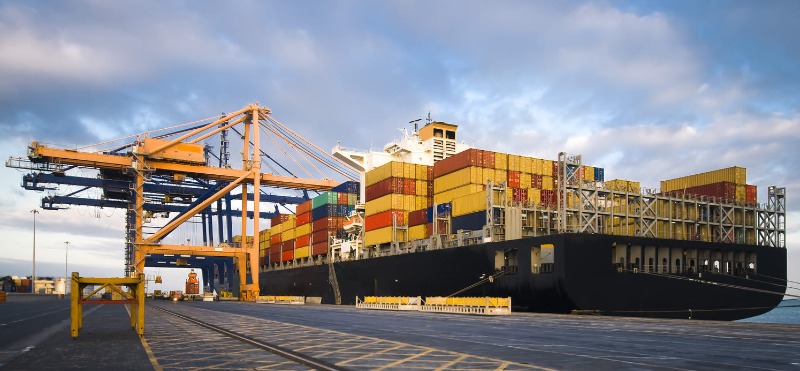Share this post
Wine logistics: safe transportation throughout the process
You’ve decided on a freight forwarder and accepted a transportation quote. What happens next? Wine logistics is the process of getting your wine to its destination, quickly, safely and at the right cost. For example, if you are a UK wine importer, buying in delicious Italian wines such as Amarone della Valpolicella, Chianti Classico and Prosecco, you’ll need to consider the best way to transport them to meet your deadline and budget.
Shipments of Italian wine to the UK make up one of Italy’s biggest trade lanes by volume. So if you’re importing them, you need to know how the process of wine logistics works and what your options are.
What is wine logistics?
Seamless wine logistics is key to a successful wine business. Wine logistics includes managing import and export, wine warehousing, and international shipping via air freight, ocean,road or rail.
Shipping from wine producing countries such as Italy to major wine importers, such as Germany, the USA and the UK, requires expert management and coordination from start to finish. Italy exported 50.2mhl of wine in 2021, making it the world's largest wine exporter. And with the continuing boom in Prosecco trade, the need for expertly managed wine logistics is only growing. Equally, the US — the largest wine market worldwide — imported about $2.8 billion worth of wine from France in 2022.
With the average wine consumption per US resident rising to 3.18 gallons in 2021, the demand for wine will only increase.
How do you transport large quantities of wine?
There are many wine logistics options to get your wine to its destination. Most cargo journeys are multimodal – using a combination of sea, road, air and rail transport. The transport mode most appropriate for your beverages will depend on the quantity of wine you want to ship, as well as their location and temperature requirements.
Road
Almost all wine shipments will travel via road at the start and end of their journey. Road haulage is quick: it can take as little as 3 days to move a full trailer of cased wine from an Italian winery to the UK, for example. Road freight can accommodate full container loads for transporting large quantities of wine in cases or in bulk wine flexitanks. It is often the easiest and fastest way to ship domestically too.
Sea
When shipping from Italy to the UK, your wine will eventually need to cross the English Channel. For a full cargo trailer, the crossing is made on a ‘Ro-Ro’ service, where the vehicle ‘rolls on and rolls off’ the boat.
Like road freight, sea freight can accommodate full container loads for large shipments. The speed of sea freight makes it more expensive than other transit modes, but there are other wine logistics options if you have enough time in your supply chain.
Rail
Carriage by rail is an alternative to road freight for transit routes over land. Rail services have longer transit times but attract a far cheaper freight rate. Rail services are also very reliable, face fewer delays and are more eco-friendly. Read our article to find out more about the different transport options.
Air
Air freight is a reliable way to get your beverages to their destination quickly. It is also a very secure way to transport wine, with a lesser risk of damage or theft than other transport modes. This makes it ideal for high-value beverages as well as time sensitive ones.
What if I only want to transport a smaller amount of wine?
If you don’t need to move a full container of cargo, there are still plenty of options. Wine logistics partners like Hillebrand Gori offer what’s known as a ‘groupage’ service. Groupage is when multiple shipping partners share a container and load your pallets with other beverages. Groupage is also known as LCL shipping but there’s a slight difference in the two services you’ll receive.
Less-than-container-load (LCL) shipping is another option offered by ‘co-loader’ or ‘consolidator’ companies. These providers don’t have a relationship with the freight payer. LCL shipping involves co-loading pallets with all types of products. You can find out more about both groupage and LCL shipping in our article here.
Transit times and costs for these services vary depending on the logistics provider you choose. But what if your order is needed faster than groupage or LCL services can accommodate?
What if I need faster wine logistics?
Sometimes you need your wine to reach its destination more quickly. It is possible to speed up a full trailer service, but you should expect to pay a higher rate. These are called express services. If required, your wine logistics partner can arrange for a dedicated vehicle and driver to collect your cargo and drive it to the delivery point.
Express shipping can be as quick as overnight, depending on the transit route and what other services are necessary. For example, using two drivers can speed up transport time by switching seats for rest breaks. The direct routes and high speed of air freight also makes for a good wine logistics solution when an express service is needed.
Choosing the right shipping container
Your wine logistics service also includes choosing the right type of shipping container for your beverages. This can depend on the conditions where the wine will be shipped from and to. In Italy’s famous Emilia-Romagna region, average temperatures in July are around 28ºC/83ºF, which is far too high for wine to be stored or transported at. Wine exposed to prolonged heat can age prematurely, change colour and lose acidity.
Keeping your wine within the ideal temperature during shipping requires careful planning and container solutions. A reefer (refrigerated) container provides to-the-degree cool temperatures, making them a good choice for transporting sensitive products. However, depending on the trade route, reefer containers can be hard to come by. Adding an insulation liner, such as the Hillebrand Gori insulation liner, to your shipping container protects your wine from fluctuating temperatures and humidity during transport.
Our supply chain and wine logistics services
Managing your supply chain time by planning shipments with a wine logistics supplier like Hillebrand Gori means you’ll be able to choose a service that both benefits your budget and gets your wine to its destination quickly and securely. Get in touch to find out more about our services, or request a free quote here.
Published 7th March 2023, updated 26th February 2024
A wine logistics expert can help you to manage the entire movement of your wine from origin to destination. They have specific knowledge in regulation and legislation, as well as customs clearance requirements.
There’s a trend towards more sustainable and eco-friendly logistics practices. This includes using Hillebrand Gori’s 100% recyclable flexitank.
They understand the unique challenges and requirements of transporting wine. They focus on product safety and quality preservation from collection to delivery.
Wine logistics can be vulnerable to risks such as theft, breakage and temperature fluctuations. You need to consider the container type you are using to transport your wines and having adequate insurance coverage.





